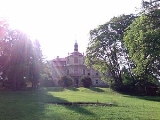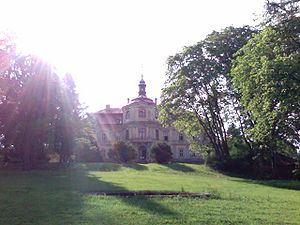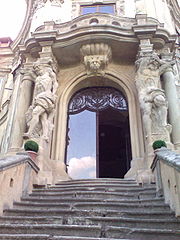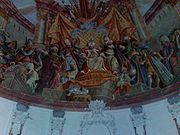
Trpisty
Encyclopedia

Baroque
The Baroque is a period and the style that used exaggerated motion and clear, easily interpreted detail to produce drama, tension, exuberance, and grandeur in sculpture, painting, literature, dance, and music...
18th century manor house
Manor house
A manor house is a country house that historically formed the administrative centre of a manor, the lowest unit of territorial organisation in the feudal system in Europe. The term is applied to country houses that belonged to the gentry and other grand stately homes...
located at Trpísty
Trpísty
Trpísty is a village and municipality in Tachov District in the Plzeň Region of the Czech Republic. The municipality covers an area of , and has a population of 235 ....
in the Plzeň Region
Plzen Region
Plzeň Region is an administrative unit in the western part of Bohemia in the Czech Republic. It is named after its capital Plzeň .- Communes :...
of the Czech Republic
Czech Republic
The Czech Republic is a landlocked country in Central Europe. The country is bordered by Poland to the northeast, Slovakia to the east, Austria to the south, and Germany to the west and northwest....
. It was built between 1723 and 1729 for Count Prosper Anton Josef von Sinzendorf
Sinzendorf
Sinzendorf:* Philipp Ludwig von Sinzendorf , cardinal of the Catholic Church* Prosper Anton Josef von Sinzendorf , Austrian noble man and courtier, Counsellor and Chamberlain...
on the site of a medieval castle.
Because the house archive was lost in the late 18th century, the identity of the architect is not clear. Recent research favours the authorship of Jakub Auguston
Jakub Auguston
Jakub Auguston jr. was an important baroque architect in Plzeň and west Bohemia. His works include, tee Chotěšov Abbey,the Church of Saint Anna and Saint Ruzena Limanska in Plzeň. He is buried in the church's crypt.,....
, an architect of Italian descent living in Pilsen (Plzeň in Czech). The extravagant layout and decoration of the house set it apart from Auguston's other works in provincial style, so Trpisty either is his best and most mature project or it has been designed by somebody else. The layout of the building is based on two pavilion
Pavilion (structure)
In architecture a pavilion has two main meanings.-Free-standing structure:Pavilion may refer to a free-standing structure sited a short distance from a main residence, whose architecture makes it an object of pleasure. Large or small, there is usually a connection with relaxation and pleasure in...
s (the North and South Wing) connected by two large oval rooms protruding in the middle of the East and West facades. The piano nobile
Piano nobile
The piano nobile is the principal floor of a large house, usually built in one of the styles of classical renaissance architecture...
on the first floor is lavishly decorated with allegorical baroque fresco
Fresco
Fresco is any of several related mural painting types, executed on plaster on walls or ceilings. The word fresco comes from the Greek word affresca which derives from the Latin word for "fresh". Frescoes first developed in the ancient world and continued to be popular through the Renaissance...
es in stucco mirrors, while the main drawing room
Drawing room
A drawing room is a room in a house where visitors may be entertained. The name is derived from the sixteenth-century terms "withdrawing room" and "withdrawing chamber", which remained in use through the seventeenth century, and made its first written appearance in 1642...
boasts a large fresco on its entire vaulted
Vault (architecture)
A Vault is an architectural term for an arched form used to provide a space with a ceiling or roof. The parts of a vault exert lateral thrust that require a counter resistance. When vaults are built underground, the ground gives all the resistance required...
ceiling depicting an apotheosis
Apotheosis
Apotheosis is the glorification of a subject to divine level. The term has meanings in theology, where it refers to a belief, and in art, where it refers to a genre.In theology, the term apotheosis refers to the idea that an individual has been raised to godlike stature...
of the Sinzendorf family and historic scenes from the Ottoman
Ottoman Empire
The Ottoman EmpireIt was usually referred to as the "Ottoman Empire", the "Turkish Empire", the "Ottoman Caliphate" or more commonly "Turkey" by its contemporaries...
Court.
The large formal garden was landscaped in the English style in the 19th century and contains today a rich collection of rare trees, among them a 19th century female Ginkgo tree.
The château, its park and outbuildings are among the last remaining examples of 18th century Bohemian country houses embedded in its original landscape without visible changes in the wake of industrialisation or subsequent destruction during the communist rule and belong to the most valuable historic estates in Central Europe
Central Europe
Central Europe or alternatively Middle Europe is a region of the European continent lying between the variously defined areas of Eastern and Western Europe...
.



